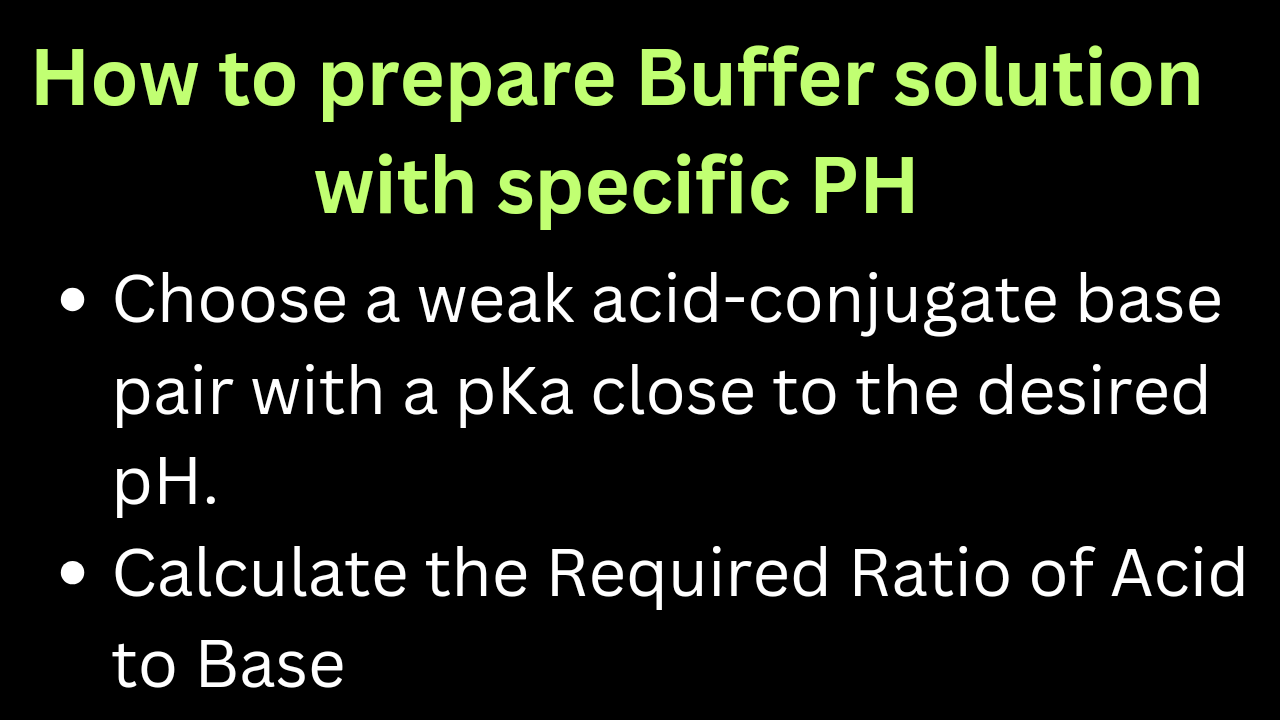A buffer solution is a solution that resists changes in pH when small amounts of acid or base are added. Buffer solutions are essential in biochemical and chemical experiments to maintain a stable pH environment.
Preparing a buffer solution with a specific pH requires understanding the principles of buffer action and careful calculations.
This article provides a step-by-step guide to creating a buffer solution with a desired pH.
What is Buffer Solutions
Buffer solutions typically consist of:
- A weak acid and its conjugate base (e.g., acetic acid and sodium acetate).
- A weak base and its conjugate acid (e.g., ammonia and ammonium chloride).
The pH of a buffer solution is primarily determined by the Henderson-Hasselbalch equation:
pH=pKa+log([A−][HA])\text{pH} = \text{pKa} + \log \left( \frac{[\text{A}^-]}{[\text{HA}]} \right)
Where:
- [A−][\text{A}^-] = concentration of the conjugate base
- [HA][\text{HA}] = concentration of the weak acid
- pKa\text{pKa} = negative logarithm of the acid dissociation constant
Buffer Solution preparation steps
1. Decide the Required pH and Buffer System
Decide the target pH and choose a weak acid-conjugate base pair with a pKa close to the desired pH. For example:
- For pH ~4.5, use acetic acid (pKa≈4.76\text{pKa} \approx 4.76).
- For pH ~7.4, use phosphate buffer (pKa≈7.2\text{pKa} \approx 7.2).
- For pH ~9.0, use ammonia buffer (pKa≈9.25\text{pKa} \approx 9.25).
2. Calculate the Required Ratio of Acid to Base
Use the Henderson-Hasselbalch equation to find the ratio of [A−][\text{A}^-] to [HA][\text{HA}]. Rearrange the equation: [A−][HA]=10pH−pKa\frac{[\text{A}^-]}{[\text{HA}]} = 10^{\text{pH} – \text{pKa}}
For example, if the desired pH is 4.5 and the pKa\text{pKa} of acetic acid is 4.76: [A−][HA]=104.5−4.76=10−0.26≈0.55\frac{[\text{A}^-]}{[\text{HA}]} = 10^{4.5 – 4.76} = 10^{-0.26} \approx 0.55
This means the concentration of the conjugate base (A−\text{A}^-) should be 55% of the concentration of the weak acid (HA\text{HA}).
3. Decide the Total Buffer Concentration
Choose the total buffer concentration based on the needs of the experiment. For example, if a 0.1 M buffer is required, the combined concentrations of [A−][\text{A}^-] and [HA][\text{HA}] should equal 0.1 M.
Using the ratio calculated: [HA]+[A−]=0.1 M[\text{HA}] + [\text{A}^-] = 0.1 \, \text{M}
Substitute [A−]=0.55×[HA][\text{A}^-] = 0.55 \times [\text{HA}] into the equation: [HA]+0.55[HA]=0.1[\text{HA}] + 0.55[\text{HA}] = 0.1 1.55[HA]=0.11.55[\text{HA}] = 0.1 [HA]=0.11.55≈0.065 M[\text{HA}] = \frac{0.1}{1.55} \approx 0.065 \, \text{M} [A−]=0.55×0.065≈0.035 M[\text{A}^-] = 0.55 \times 0.065 \approx 0.035 \, \text{M}
4. Prepare the Buffer Components
Weigh the appropriate amounts of the weak acid and its conjugate base. For example:
- To prepare an acetic acid-sodium acetate buffer, use acetic acid for [HA][\text{HA}] and sodium acetate for [A−][\text{A}^-].
- Use the molecular weights to calculate the mass required.
5. Mix the Components in Water
- Dissolve the calculated amounts of the acid and base in distilled water.
- Adjust the total volume to the desired final volume (e.g., 1 L).
6. Adjust the pH if Necessary
After mixing, check the pH using a calibrated pH meter. If the pH is not exactly at the desired value:
- Add small amounts of strong acid (e.g., HCl) to lower the pH.
- Add small amounts of strong base (e.g., NaOH) to raise the pH.
Example: Preparing 1 L of a pH 4.5 Buffer with 0.1 M Acetic Acid and Sodium Acetate
- [HA]=0.065 M[\text{HA}] = 0.065 \, \text{M}, [A−]=0.035 M[\text{A}^-] = 0.035 \, \text{M}
- Molecular weight of acetic acid = 60.05 g/mol; sodium acetate = 82.03 g/mol.
- Mass of acetic acid = 0.065 M×1 L×60.05 g/mol=3.90 g0.065 \, \text{M} \times 1 \, \text{L} \times 60.05 \, \text{g/mol} = 3.90 \, \text{g}.
- Mass of sodium acetate = 0.035 M×1 L×82.03 g/mol=2.87 g0.035 \, \text{M} \times 1 \, \text{L} \times 82.03 \, \text{g/mol} = 2.87 \, \text{g}.
- Dissolve 3.90 g of acetic acid and 2.87 g of sodium acetate in water, then dilute to 1 L.
- Check and adjust the pH.
Tips for Successful Buffer Preparation
- Always calibrate your pH meter before use.
- Use high-purity reagents to avoid contamination.
- Minimize temperature fluctuations, as pH can vary with temperature.
- Store the buffer in a clean, airtight container to prevent contamination.

2 thoughts on “How to prepare a buffer solution of a specific PH”